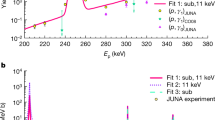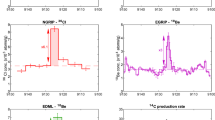Abstract
THE high abundance of radioactive 26A1 in meteoritic materials1 presents a puzzle in attempts to describe the formation of the Solar System. It has been suggested11 that collapse of the solar nebula may have been accompanied by an injection of 26A1 from nucleosynthesis in a neighbouring star. The relatively high level of 26A1 in the interstellar medium2,3 is also unexplained. Here I suggest that this isotope may be formed in nuclear reactions between hydrogen and heavy cosmic rays. This suggestion is prompted by the recent discovery4 of γ-ray line emission from 12C and 16O in the Orion cloud complex, thought to be caused by the interaction of these cosmic-ray ions with interstellar hydrogen. I show that these observations also imply enhanced production of 26A1 in the Orion molecular clouds, and that such nuclear reactions can account for the meteoritic abundances. Reactions involving heavy cosmic rays might also account for the presence of other extinct radioactive nuclides in meteorites.
This is a preview of subscription content, access via your institution
Access options
Subscribe to this journal
Receive 51 print issues and online access
$199.00 per year
only $3.90 per issue
Buy this article
- Purchase on Springer Link
- Instant access to full article PDF
Prices may be subject to local taxes which are calculated during checkout
Similar content being viewed by others
References
Lee, T., Papanastassiou, D. A. & Wasserburg, G.J. Astrophys. J. 211, L107–L110 (1977).
Share, G. H. et al. Astrophys. J. 292, L61–L65 (1985).
Diehl, R. et al. in Compton Gamma Ray Observatory (eds Friedlander, M., Gehrels, N. & Macomb, D.) 40–46 (Am. Inst. Phys., New York, 1993).
Bloemen, H. et al. Astr. Astrophys. 281, L5–L8 (1994).
Ramaty, R., Kozlovsky, B., & Lingenfelter, R. Astrophys. J. Suppl. Ser. 40, 487–522 (1979).
Mewaldt, R. A. Rev. Geophys. Space Phys. 21, 295–305 (1983).
Kozlovsky, B., Lingenfelter, R. & Ramaty, R. Astrophys. J. 316, 801–818 (1987).
Clayton, D. D., Dwek, E. & Woosley, S. E. Astrophys. J. 214, 300–315 (1977).
Lang, F. L., Werntz, C.W., Crannell, C. J., Trombka, J. I. & Chang, C. C. Phys. Rev. C35, 1214–1227 (1987).
Clayton, D. D., Hartmann, D. H. & Leising, M. D. Astrophys. J. 415, L25–L29 (1993).
Cameron, A. G. W. in Protostars and Planets Vol. 3, (eds Levy, E. & Lunine, J.) 47 (Univ. of Arizona, Tucson, 1993).
MacPherson, G. J., Wark, D. A. & Armstrong, J. T. in Meteorites and the Early Solar System (eds Kerridge, J. F. & Mathews, M. S.) 746–807 (Univ. of Arizona, Tucson, 1988).
Virag, A., Zinner, E., Amari, S. & Anders, E. Geochim. cosmochim. Acta 55, 2045–2062 (1991).
Shokulyukov, A. & Lugmair, G. Science 259, 1138–1142 (1993).
Wasserburg, G. J., Busso, M., Gallino, R. & Raiteri, C. M. Astrophys. J. (in the press).
Birck, J.-L. & Lugmair, G. Earth planet. Sci. Lett. 90, 131–135 (1988).
Clayton, D. D. Nature 257, 36–37 (1975).
Podosek, F. A. & Swindle, T. D. in Meteorites and the Early Solar System (eds Kerridge, J. F. & Mathews, M. S.) 1093–1146 (Univ. of Arizona, Tucson, 1988).
Clayton, D. D. Astrophys. J. 268, 381–384 (1983).
Clayton, D. D. & Leising, M. D. in Compton Gamma Ray Observatory Symposium 2 (ed. Gehrels, N.) (Am. Inst. Phys., New York, in the press).
Harper, C. L. & Wiesmann, H. Astrophys. J. (submitted).
Birck, J. L. & Allegre, C. J. Geophys. Res. Lett. 12, 745–748 (1985).
Lugmair, G. W., Maclsaac, C. & Shukolyukov, A. Lunar planet. Sci. 23, 823–824 (1992).
Kelly, W. R. & Wasserburg, D. J. Geophys. Res. Lett. 5, 1079–1082 (1978).
Author information
Authors and Affiliations
Rights and permissions
About this article
Cite this article
Clayton, D. Production of 26A1 and other extinct radionuclides by low-energy heavy cosmic rays in molecular clouds. Nature 368, 222–224 (1994). https://doi.org/10.1038/368222a0
Received:
Accepted:
Issue Date:
DOI: https://doi.org/10.1038/368222a0
Comments
By submitting a comment you agree to abide by our Terms and Community Guidelines. If you find something abusive or that does not comply with our terms or guidelines please flag it as inappropriate.



